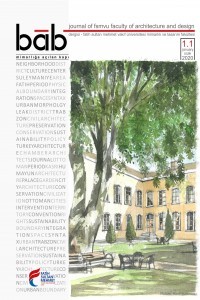Mimari Mirasın Korunmasına Dair Özgün Bir Örnek: ‘Gelenekten Cittaslow’a’ Taraklı
Sakin Şehir, tarihi mahalle, geleneksel konut, sivil mimarlık, koruma örneği
A Special Case for The Preservation of The Architectural Heritage: From Traditional to Cittaslow ‘Taraklı’
Cittaslow, historical neighborhood, traditional house, civil architecture, protection case,
___
- BEATLEY, T., 2004. Native to nowhere: sustaining home and community in a globe age. Washington DC: Island Press.
- ERDOĞAN, N. ve AKARSU, H. T., 2018. Gelenekten Cittaslow’a Taraklı. İstanbul: Verita Yayınları.
- OKUTAN, N., 2007. Alternatif turizm yeri adresi Sakarya. Sakarya Valiliği, Sakarya: Seçil Ofset Matbaası.
- PARKINS, W. ve CRAIG, G., 2006. Slow living. New York: Berg Publishers.
- RADSTROM, S., 2005. An urban identity movement rooted in the sustainability of place: a case study of slow cities and their application in rural. Manitoba: The University of Manitoba Department of City Planning.
- SEZGİN, M. ve ÜNÜVAR, Ş., 2011. Sürdürülebilirlik ve şehir pazarlaması ekseninde yavaş şehir. Konya: Çizgi Kitabevi.
- KONUKÇU, E., 2005. Osmanlı devleti kuruluş döneminde Sakarya bölgesi. İçinde: N. DEMİR, ed. Sakarya ili tarihi. İstanbul: Kaya Matbaacılık. s. 65-88.
- ANONİM, 1984. I Sakarya. İçinde: Yurt Ansiklopedisi. Cilt 9. İstanbul: Anadolu Yayıncılık.
- BİLGİ, M. G., 2013. Türkiye’nin sakin şehirlerinde permakültürel koruma, planlama, yönetim ve eğitim pratikleri. Selçuk Üniversitesi Sosyal Bilimler Enstitüsü Dergisi. 29, s. 45-59.
- ÇETIN, Y., 2007. Sakarya ve çevresinde ev örnekleri. Güzel Sanatlar Enstitüsü Dergisi. 19, s. 67-103.
- DONALDSON, R., SPOCTER, M., PLESSİS, D. D. ve NİEKERK, A. V., 2012. Towards generic interventions to stimulate growth potential in small towns of the Western Cape province. South Africa.South African Geographical Journal. 94 (2), s. 120-136.
- ERDOĞAN, N., 2020. Evaluation of Cittaslow standards’ traditional urban texture and buildings aspects: from Traditional to Cittaslow-Taraklıc Case. Journal of Architectural Science and Application. 5 (1), s. 108-118.
- GÜVEN, E., 2011. Yavaş güzeldir: Yavaş yemek’ ten yavaş medya’ya hızlı tüketime dair bir çözüm önerisi. Selçuk İletişim Dergisi. 7 (1), s. 113-121.
- HATİPOĞLU, B., 2015. Cittaslow: Quality of life and visitor experiences. Tourism Planning &Development. 12 (1), s. 20-36.
- KARABAĞ, Ö., YÜCEL, F. ve İNAL, E., 2012. Cittaslow movement: an opportunity for branding small towns and economic development in Turkey. International Journal of Economic Research. 313, s. 64-75.
- KARATAŞ, A. ve KARABAĞ, Ö., 2013. Cittaslow hareketinde çevre eğitiminin önemi. Balıkesir Üniversitesi Sosyal Bilimler Enstitüsü Dergisi. 16 (29), s. 1-21.
- KESKİN, E. B., 2011. Sürdürülebilir kent kavramına farklı bir bakış: Paradoksekonomik. Sosyoloji ve Politika Dergisi. 8 (1), s. 81-99.
- KNOX, P. L., 2005. Creating ordinary places: slow cities in a fast World. Journal of Urban Design. 10 (1), s. 1-11.
- MAYER, H. ve KNOX P. L., 2006. Slow Cities: Sustainable places in a fast world. Journal Of Urban Affairs. 28 (4), s. 321-334.
- RADSTROM, S., 2011. A place-sustaining framework for local urban identity: An introduction and history of cittaslow. Italian Journal of Planning Practice. 1 (1), s. 90-113.
- SEMMENS, J. ve FREEMAN, C., 2012. The Value of cittaslow as an approach to local sustainable development: A New Zealand perspective. International Planning studies. 17 (4), s. 353-375.
- YILDIRIM, A. ve KARAHMET, A., 2013. Yavaş şehir hareketinin kent imajına katkısı: Ordu-Perşembe örneğinin yerel basın Üzerinden Analizi. Sosyal ve Beşeri Bilimler Dergisi. 5 (1), s. 11-20.
- YURTSEVEN, H. R. ve KAYA, O., 2011. Slow tourists: a comparative research based on cittaslow principles. American International Journal of Contemporary Research. 1 (2), s. 91-98.
- LOWRY, L. ve LEE, M., 2011. CittaSlow, slow cities, slow food: Searching for a model for the development of slow tourism.Travel & Tourism Research Association. 42nd annual conference proceedings; Seeing the Forest and the Trees – Big Picture Research in a Detail- Driven World, 19-21 Haziran 2011, London: Ontario, Canada. s. 10-21.
- CITTASLOW SUNDAY, 2020. Cittaslow sunday 2019 [çevrimiçi]. Erişim adresi: https://www.cittaslow.org/news/cittaslow-sunday-2019 [Erişim tarihi 30 Mart 2020].
- CITTASLOW, 2019. International network of cities where living is good [çevrimiçi]. Erişim adresi: http://www.cittaslow.org/ [Erişim tarihi 18 Haziran 2019].
- ÖZBURSALI, Z. T., 2018. Konut illüstrasyonları. [resim] Nevnihal Erdoğan Kişisel Arşivi, Kocaeli.
- Yayın Aralığı: Yılda 2 Sayı
- Başlangıç: 2020
- Yayıncı: Fatih Sultan Mehmet Vakıf Üniversitesi
Ofis İç Mekanının Covid-19 Pandemisi Sonrası Yeniden Düzenlenmesi
F. Ceyda GÜNEY YÜKSEL, Füsun SEÇER KARİPTAŞ, Fatih KARİPTAŞ
19. Yüzyıl Ayasofya Camii ve Külliye Onarımlarında Yapılan Harcamaların Değerlendirilmesi
Bayram AKKOYUN, Büşra KORKMAZ, Fatma Esra TORAMAN
Çocuğun Odası ile İlişkisinin Esneklik Kavramı Üzerinden İncelenmesi
Mimari Mirasın Korunmasına Dair Özgün Bir Örnek: ‘Gelenekten Cittaslow’a’ Taraklı
Postmodern Düşüncenin Mekan Açılımı Üzerine Kavramsal Bir Deneme: Arada Mekan
Gülsüm KARAÇETİN SARIKAYA, Senem KAYMAZ
Merve GÖK, Mustafa Lütfi YAZICIOĞLU
İlhan KOÇ, Mehmet Oğuz DURU, Sevde Gülizar DİNÇER
Mimar Adayları İçin Uzamsal Yetenekleri Geliştirmeye Yönelik Eğitici Bir Oyun Önerisi
